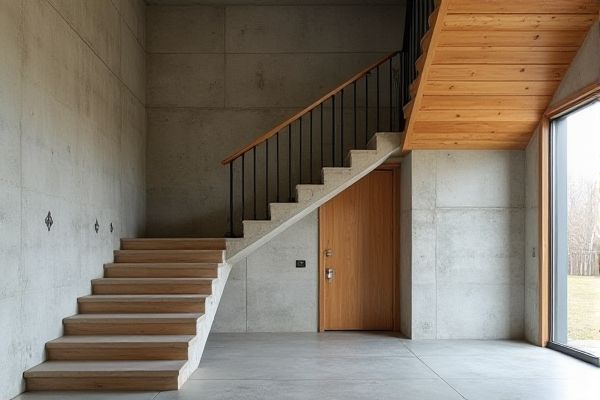
Reinforced concrete stairs offer superior durability, fire resistance, and load-bearing capacity compared to timber stairs, making them ideal for long-term structural applications. Your choice between these materials depends on factors such as budget, aesthetic preferences, and maintenance requirements; read on to explore the detailed pros and cons of both options.
Table of Comparison
| Feature | Reinforced Concrete Stairs | Timber Stairs |
|---|---|---|
| Durability | High resistance to weather, fire, and wear; lasts decades | Moderate; susceptible to rot, insects, and fire without treatment |
| Strength | Excellent structural strength; supports heavy loads | Good strength; suitable for light to medium loads |
| Maintenance | Low maintenance; occasional cleaning | Requires regular sealing, painting, and inspections |
| Installation Time | Longer; involves curing time | Shorter; prefabricated options available |
| Cost | Higher initial cost due to materials and labor | Lower initial cost |
| Aesthetic Flexibility | Limited; mainly concrete finish or coverings | High; variety of wood types and finishes |
| Environmental Impact | Higher carbon footprint due to cement production | More sustainable if sourced responsibly |
| Fire Resistance | Highly fire-resistant | Low fire resistance |
Introduction to Reinforced Concrete and Timber Stairs
Reinforced concrete stairs are constructed using concrete combined with steel reinforcement bars, offering exceptional durability, load-bearing capacity, and fire resistance suited for both residential and commercial buildings. Timber stairs, made from solid wood or engineered lumber, provide aesthetic warmth and versatility in design but require regular maintenance to prevent damage from moisture and pests. The choice between reinforced concrete and timber stairs depends on structural requirements, desired architectural style, and long-term performance considerations.
Design Considerations for Stairs
Reinforced concrete stairs offer superior durability, load-bearing capacity, and fire resistance, making them ideal for high-traffic or commercial buildings, while timber stairs provide design flexibility, aesthetic warmth, and ease of customization suited for residential spaces. Your choice should consider factors such as span length, structural load requirements, maintenance preferences, and local building codes governing materials and fire safety. Effective stair design also accounts for tread dimensions, rise consistency, and balustrade integration to ensure safety and comfort.
Structural Strength and Durability Comparison
Reinforced concrete stairs offer superior structural strength and durability compared to timber stairs, making them ideal for high-traffic or outdoor areas where longevity is critical. Concrete stairs resist warping, rot, and insect damage, whereas timber stairs require regular maintenance to protect against environmental wear and structural degradation. Your choice should consider the expected load and environmental exposure, with reinforced concrete providing a low-maintenance, long-lasting solution.
Installation Process: Reinforced Concrete vs Timber
Reinforced concrete stairs require a more complex and time-consuming installation process involving formwork setup, concrete pouring, and curing, ensuring durability and strength. Timber stairs offer a quicker and more flexible installation, with prefabricated components that can be easily adjusted on-site but may require additional treatments for longevity. Your choice depends on whether you prioritize the long-lasting stability of concrete or the faster, adaptable installation of timber.
Cost Analysis and Budget Implications
Reinforced concrete stairs typically involve higher initial costs due to materials like cement, steel reinforcements, and labor-intensive construction processes, but they offer long-term durability and low maintenance expenses. Timber stairs generally have lower upfront costs and faster installation times, yet may incur higher maintenance and replacement costs over time due to susceptibility to wear, rot, and pests. Evaluating your budget implications requires balancing the concrete stairs' higher durability and lifecycle cost savings against timber stairs' immediate affordability and aesthetic appeal.
Maintenance Requirements and Lifespan
Reinforced concrete stairs offer superior durability with minimal maintenance, often lasting over 50 years without significant repairs, making them ideal for high-traffic areas. Timber stairs require regular upkeep such as sealing, staining, or painting to prevent rot and insect damage, typically lasting around 20-30 years depending on exposure and care. Your choice depends on balancing the long-term low maintenance and extended lifespan of concrete with the aesthetic warmth but higher upkeep demands of timber stairs.
Aesthetic Options and Customization
Reinforced concrete stairs offer a wide range of aesthetic options, including various finishes such as polished, painted, or tiled surfaces, allowing for durable and modern design choices. Timber stairs provide greater customization in shape, texture, and stain color, giving a warm and natural appeal that can be tailored to match your interior style. Your decision depends on whether you prioritize the robust versatility of concrete or the classic, customizable beauty of wood.
Environmental Impact and Sustainability
Reinforced concrete stairs have a higher environmental impact due to cement production's significant carbon emissions, whereas timber stairs offer enhanced sustainability through their renewable nature and carbon sequestration during growth. Timber sourced from responsibly managed forests reduces deforestation risks and promotes biodiversity, making it a greener option compared to concrete. However, concrete's durability and low maintenance lifespan can offset some environmental costs over time, highlighting the importance of lifecycle analysis in material selection.
Safety and Building Code Compliance
Reinforced concrete stairs offer superior fire resistance and structural durability compared to timber stairs, making them more compliant with stringent building codes and safety regulations. Timber stairs require careful treatment and maintenance to meet fire safety standards and structural strength criteria, often necessitating the use of fire retardants and load-bearing analysis. Building codes typically mandate reinforced concrete for high-traffic or commercial buildings, ensuring enhanced safety through non-combustibility and long-term stability.
Choosing the Right Stair Material for Your Project
Reinforced concrete stairs offer superior durability, fire resistance, and low maintenance, making them ideal for high-traffic or outdoor applications where strength and longevity are critical. Timber stairs provide aesthetic warmth, design flexibility, and easier installation, suited for residential or interior spaces emphasizing style and comfort. Evaluating factors such as structural load, environmental exposure, budget, and desired finish will guide the optimal material choice for your staircase project.
 homyna.com
homyna.com